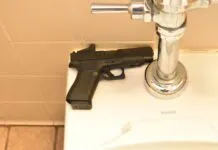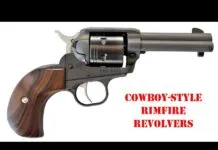Alot of people are buying shotguns for home protection these days. Theres a lot to be said for that, because a shotgun requires little training to be effective, the overall costs are relatively low, and the deterrent effect is on the awesome side, even though no shots may be fired. But what shotgun to get? What type and gauge is best? Thatll depend on your location and type of home to some extent, but there are some absolutes. Beginning with caliber, the 12-gauge has the most to offer in load variety, availability, and ammo cost. While there are good arguments for smaller calibers, particularly when light, young, or recoil-sensitive personnel may be using the gun, for this report we considered only the 12-gauge.
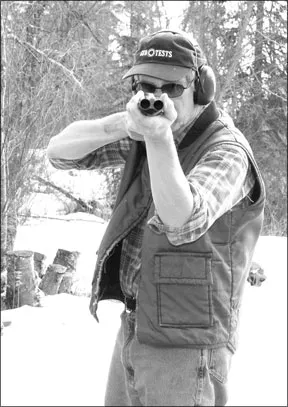
We had never compared “police” shotguns with double side-by-sides, so decided to have a look at the two to see if there are obvious or perhaps hidden advantages to one type over the other. We chose a police-type Remington 870 Express Magnum Folding Stock, 12-gauge pump (MSRP $505) to test against a double SXS Stoeger Coach Gun, made in Brazil by E.R. Amantino (MSRP $369). Both had 3-inch chambers.
Although the Stoeger had 20-inch barrels, it was 2.5 inches shorter at 36.5 inches overall than the 870 with its 18.5-inch tube. Of course you can fold the stock on the Remington to give an overall length of 29.3 inches and itll still be functional. We tested with three types of ammunition. These were 2.75″ Federal 1-ounce #8 Game-Shok, 2.75″ Estate 1.25-ounce High-Velocity Hunting loads, and with 3″ Winchester XX Magnum 00 Buckshot (15 pellets). While the obvious difference between these two guns is many shots versus two, thats by no means the whole story. Lets take a closer look.
Stoeger Coach Gun
No. 31400 12 Gauge, $369
There are six variants of the Coach Gun, all of which have walnut stocks and double triggers. Ours was the lowest-priced version. Our test gun came with no recoil pad and without the questionable hassle of screw-in chokes. It had fixed Improved Cylinder and Modified chokes. Other variants of the gun (www.stoegerindustries.com) have interchangeable choke tubes, matte or polished nickel finishes on the metal, different stock finishes, and several have recoil pads. One version that caught our eye had a straight-hand, English-type stock. None have ejectors. All versions but ours cost $469. Workmanship was quite good, we thought. The metal polish and bluing were more than just decent. The tang safety moved appropriately and was checkered for good control. The forend showed some raw and slightly rough wood on its interior, but a quick rub with linseed oil fixed that. The checkering was not real sharp, more like flat-top English checkering, but it worked well enough. The forend was large and hand filling, and in the heat of Cowboy Action shooting, for which this gun was designed, that wood keeps your hands off the hot barrels.
The gun was a simple boxlock design. It opened easily with the top lever. The firing pins were bushed, a nice touch, we thought. This gun did not have ejectors, which makes it legal for Cowboy Action shooting. Ejectors could make it a better fighting shotgun in that they would speed reloading, but theyre not available. The top
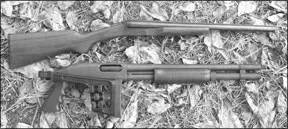
tang safety was automatic, and we feel thats a mistake. Every time you open the gun the safety goes on. In the heat of any kind of battle, real or pseudo, you dont want to have to fight that safety. Youll always have time to put it on after the fight, but maybe not enough time to take it off every time you open and close the gun. Wed change that setup right now, if we owned this one.
While the gun is apart, another problem could be fixed. When we first tried the gun we thought the safety was on, because we could not make the gun fire. We eventually found it took a whopping 11 pounds to get the gun to go bang. It felt like less on the left barrel because of the added leverage. Eleven pounds is simply way too much trigger to fight, and that pull would get fixed while the gun is apart having the auto safety disengaged. No, altering the automatic safety is not a recommendation to defeat a safety feature of the gun. Instead, its a strongly suggested modification that might save your life some day. We presume the owner of the gun will fully understand and be familiar with the gun before he or she handles or loads this shotgun.
On the range we found the Stoeger SXS to be fast, simple, easy to use, and generally foolproof. Balance was excellent, and the gun shot where it looked. The front bead was well matched to the level, file-cut rib. It was easy to put two fast shots right where we wanted them. Reloading was not all that slow if we first elevated the barrels when opening the gun, so gravity would help get out the empties. The gun could be fired with two rounds held in reserve in the forward hand. For best results, that forward hand never leaves the forend. To get a new round, you reach forward with the firing hand, grab what you need, and-keeping your eyes
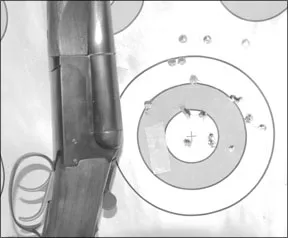
on the target-dunk the fresh ammunition into the chamber. Practice this and four quick shots will come easily. An elastic cuff on the butt stock holding a few more rounds would make this a handy setup indeed.
The Coach Gun was relatively light at 6.5 pounds. Recoil was not bad with our light game loads and tolerable with the high-velocity game loads, but was simply ferocious with 3-inch 00 buckshot. Also, we found the Stoeger was difficult to open after firing two of the 3-inch buckshot or even high-velocity 1.25-ounce hunting loads. A 6.5-pound shotgun like this, and Rugers fine new SXS double is another example, does not need 3-inch chambers. Were sure Stoeger and Ruger put 3-inch chambers in their guns to avoid problems when someone inadvertently touches off a long shell in a short chamber. But these light guns are at home with one-ounce loads and not much more. The Stoeger worked very well rapid fire with the 1-ounce game loads. Firing the first two of these was faster than two out of the 870, but the reload took lots of time. We were able to get off four rounds in about 10 seconds.
Youd have to plan your own home defense loads according to your individual setup, but in general, penetration of, say, No. 8 shot will be less than that of 00 buck, and just as effective inside 15 feet. If you must use the heavier loads, you may want to put on a recoil pad, either permanently or by means of a slip-on pad, if you can tolerate a bit more pull length. For what its worth, the Coach
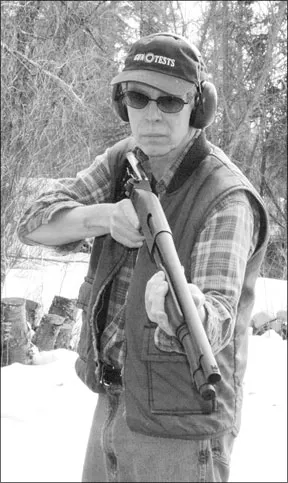
Guns right IC barrel made a great pattern about 6″ in diameter at 15 feet with the rompin, stompin buckshot load. The Remingtons pattern at that range was about 2 inches.
Remington 870 Express
Magnum Folding Stock
12 Gauge, $505
This was an impressive-looking gun. With its matte-black Parkerized finish and side-folding stock it looked all business. The newest versions of this gun have a screw-in, recoil-reducing brake on the front. Ours did not. It had a Cylinder-choked tube without threading for inserts. The magazine extension permitted the loading of 6 + 1 rounds, and the stock held three more in reserve. Short of an all-out war we dont think anyones going to need all those rounds for much of anything. They add weight to an already heavy gun. But of course we may be wrong, and if you have the 870, why, youve got em there at your disposal. Some areas may not permit the average guy to own such a shotgun, either because of the magazine capacity or the folding stock. Your local dealer will know.
The workmanship was excellent. The forend was well serrated to aid grasping, and came back only half an inch over the front of the action. It was matte-black polymer that matched the metal finish. The pistol-grip stock was securely attached to the action. The stock had two locked positions, open and shut, and all the operations of the shotgun could be utilized with the stock
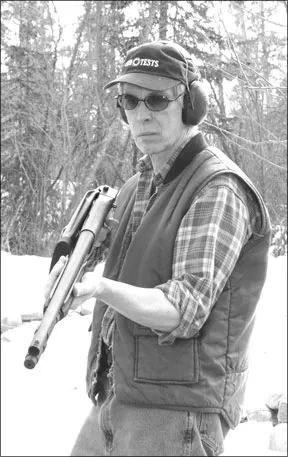
deployed or folded. To fold it, simply press the button. We occasionally found it sticky.
The stock, except for the hinge, was of polymer. The arm where your face goes was hard, unforgiving, and kept the face of a right-handed shooter well off to the side, making sight alignment impossible. The safety was Remingtons standard cross bolt behind the trigger, not the handiest place for it. The trigger pull was clean, breaking at 4.7 pounds.
Our first impression of the 870 Folding Stock on the range was entirely negative, and stayed that way throughout the course of our shooting. Nothing about this gun was shooter friendly except the excellent mechanism of the 870 itself. The mechanism was superlative, slick, foolproof, positive, as good as a pump gun gets. However, the addition of this folding contraption puts this gun into the realm of a bad joke for all who fall sucker to its macho charm. Shoulder the gun and its impossible for a right-handed shooter to align his face with the action so he can get proper aim, with the head in anything like an erect position. If you lay your head hard over to the right so you can squint down the back of the receiver, your chin or cheek is now in solid contact with the nearly square-cornered, hard, sharp, unforgiving edge of the stock. Press the trigger on anything but a light game load and youre going to get a nasty paste in the chops. This is foolishness in the extreme. Lefties would have an easier time of it, but if they crawl the stock, theyre going to get cut by the sharp edge of the stock hinge. The hard-rubber recoil pad was marginally useful.
One of our staff wanted to own this gun before anyone had shot it.
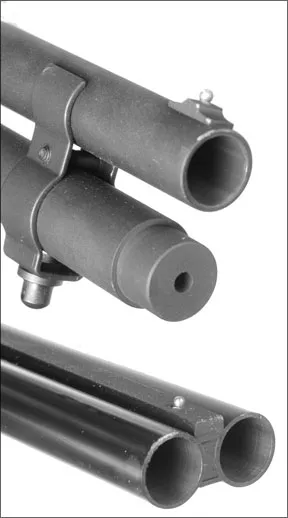
Four light-recoiling rounds later and he wanted nothing more to do with it. This, we all thought, is no way to make a gun. There are partial fixes. One solution (discovered on the Internet) is to wrap the arm of the stock with thick water-pipe insulation, which helps cushion the face while retaining the folding capability of the stock. Another is to buy the gun with a normal stock.
We tried shooting the 870 with the stock folded. Our “target” was a snow bank just over 20 feet away. Without the ability to shoulder the gun you have to guess where to point it, and that was not easy. You cant put the gun in front of your face because of the exposed, sharp steel edge of the stock mechanism. If you get too close, youll carve your face open. So you keep the gun well out in front of you and take your best guess. Guessing takes time, especially if theres any distance involved.
Although we hit our target, it took longer than to simply slap the Stoeger double up to our shoulder and cut loose. The folded stock lets you maneuver in tight quarters, and that may be important. But as always, the purpose of shooting is hitting the target, and that can best be done by putting the gun securely against your shoulder and using the front sight.
We tried rapid fire with the light ammo and the stock folded. We quickly found that unless your last name is Rambo, you wont shoot many rounds that way, not even with the lightest commercial rounds available. It hurts! The right hand takes a real beating.
The 870 was much more controllable with the stock extended. If you buy one of these and come to realize the limitations of that folded stock, we suspect youll use the gun with the stock fully extended all the time. So what good is that stock? For us, not much. For yonder policeman theres the intimidation factor, and the potential need for tight-quarters use. But if that cop knows his gun, hell probably have that stock extended.
We tried the 870 with the 3-inch 00 buckshot, and after one round on the paper at 15 feet we knew all we needed to know about this gun with heavy loads. It was brutal, to the point of uncontrollability. You cant shoot it with your face on the stock. As we said of the light Stoeger, hot 3-inch loads have no place in this gun. Recoil recovery takes too long, pain is too high, and penetration is usually excessive with 00 buckshot.
By startling contrast we shot the 870 rapid fire, stock extended, our face clear of the gun, shooting four of our light game loads. With essentially no training we could shoot all four in about five seconds, placing our shots exactly where we wanted them at 15 feet. With training wed easily get our time under four seconds. Extend the range to more than 20 feet and wed want a better stock, which would give better accuracy. Four shots with the double Stoeger took around 10 seconds, but the first two shots were much faster than the first two from the Remington, and shot placement was superior because of our solid contact with the double gun. How many shots will you need to shoot?



